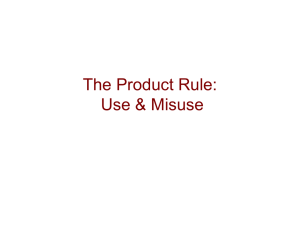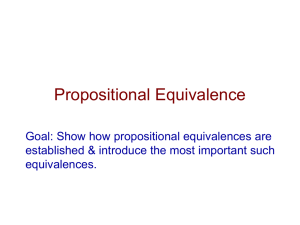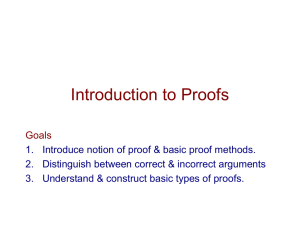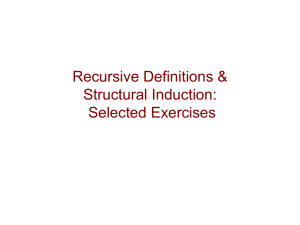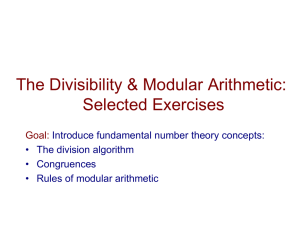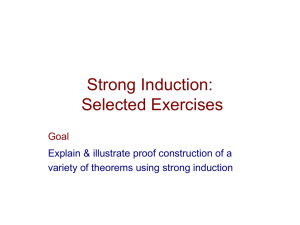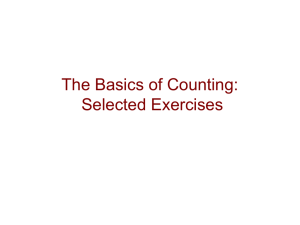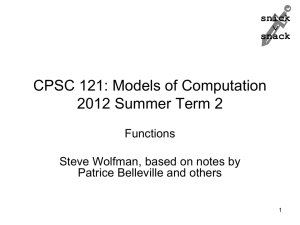2.3
advertisement
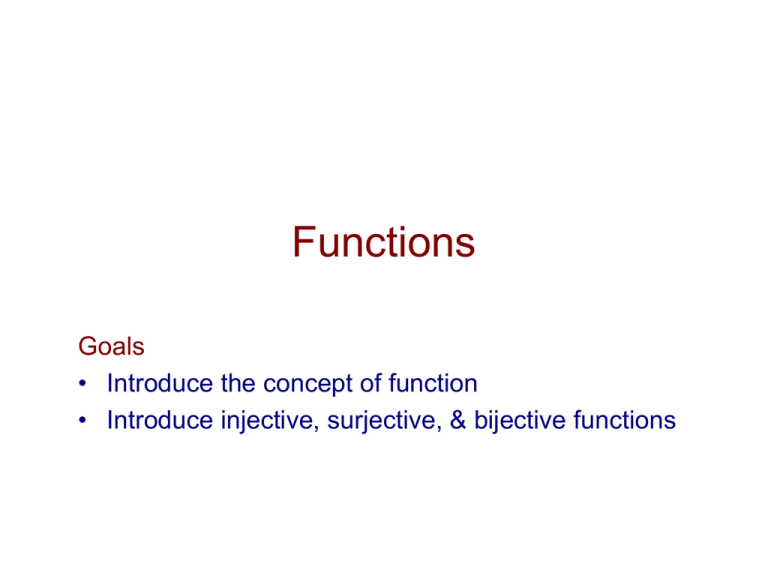
Functions
Goals
• Introduce the concept of function
• Introduce injective, surjective, & bijective functions
Definition
• Let D & C be nonempty sets.
• Function f from D to C assigns elements of D to elements of
C:
For each d D, f assigns d to exactly 1 element c C,
denoted f( d ) = c.
d D c C ( f( d ) = c c’ C ( f( d ) = c’ c = c’ ) )
d D !c C f( d ) = c.
Copyright © Peter Cappello
2
• If f is a function from D to C, we write f : D C.
• Functions also are known as:
Mappings
Transformations.
• Functions pass the vertical line test.
Copyright © Peter Cappello
3
Definition
• A function is a subset of a Cartesian product:
If f : D C then f D x C.
• If f : D C then:
D is f’s domain
C is f’s codomain.
• If f( d ) = c then:
c is the image of d
d is a pre-image of c.
• f’s range is { c | d f( d ) = c }.
Copyright © Peter Cappello
4
Example
• Let f : Z N be f( x ) = x2.
• What is f’s domain?
• What is f’s codomain?
• What is the image of 4?
• What is the pre-image of 4?
• What is f’s range?
Copyright © Peter Cappello
5
When are functions equal?
Let f1: D C &
f2: D C.
Since
– A function is a subset of a Cartesian product.
– A Cartesian product is a set.
when does f1 = f2 ?
Copyright © Peter Cappello
6
Declaring a function’s domain &
codomain
The Java statement
long square( int x ) { … }
The domain of square is?
Its codomain is?
Copyright © Peter Cappello
7
The Image of a Set
• Let f : D C and S D.
• The image of S under f, denoted f( S ) is
{ c | s S, f( s ) = c }.
• If S is finite, can | S | be <, =, or > | f( S ) | ?
• Let f : N N , f( n ) = n mod 5.
– What is f’s range?
– Let O = { n N | n is odd } .
– What is f( O ) ?
Copyright © Peter Cappello
8
One-to-One (Injective) Functions
• Let f : D C.
• f is one-to-one (injective) when
a D b D ( a b f (a ) f( b ) ).
Different domain elements have different images.
• Example
– Let n: { T, F } { T, F }, such that n( p ) = p.
– Is n injective?
• Is f : Z Z, f( z ) = z2 injective?
• Injective functions pass the horizontal line test.
Copyright © Peter Cappello
9
Onto (Surjective) Functions
• Let f : D C.
f is onto (surjective) when
c C d D ( f( d ) = c ).
f’s range equals its codomain.
• Example
– Let or : { T, F } { T, F } { T, F }, such that
or( p, q ) = p q.
– Is or surjective?
• Is f : Z Z, f( z ) = z2 surjective?
• Is f : Z Z, f( z ) = z mod 5 surjective?
• Is f : Z { 0, 1, 2, 3, 4}, f( z ) = z mod 5 surjective?
Copyright © Peter Cappello
10
One-to-One Correspondence
(Bijection)
• Function f is a one-to-one correspondence (bijection)
when it is both:
one-to-one (injective)
onto (surjective).
• Let f : R R, f( x ) = 2x – 7. Is f a bijection?
• Let f : D C be a bijection, where D, C are finite.
– Can |D| > |C|?
– Can |D| < |C|?
Copyright © Peter Cappello
11
Inverse Functions
• Let g : D C be a bijection.
• The inverse function of g, denoted g-1, is the
function : C D such that if g( d ) = c, then g-1( c ) = d.
• If g is bijective, g-1 is a function because g is:
– onto: c C ( c is the image of some element in D )
– 1-to-1: c C (c is the image of at most 1 element in D )
– Diagram this.
• If g : D C is not a bijection, does g-1 exist (as a function)?
Always? Sometimes? Never?
Copyright © Peter Cappello
12
Composition of Functions
• Let functions f : B C & g: A B.
• The composition of f & g, denoted f g,
is defined as f g( a ) = f( g( a ) ), for a A
a
g( a )
f(g( a ))
A
B
C
Copyright © Peter Cappello
13
Example
• Let f : Q Q, f( x ) = 2x + 1.
• Let g : Q Q, g( x ) = ( x – 1 ) / 2.
• What is ( g f )( 17 )?
• In general, what is g-1 g ( x ) ?
Copyright © Peter Cappello
14
Exercise
Let S U. The characteristic function of S
fS : U { 0, 1 } is such that
x S fS ( x ) = 1
A
x S fS ( x ) = 0.
3
B
4
2
Show that:
f A B (x) = fA( x )fB( x )
1
f A B (x) = fA( x ) + fB( x ) - f A B ( x )
Copyright © Peter Cappello
15
End of Lecture
Copyright © Peter Cappello 2011
16
• The Java statement
long square( int x ) { … }
square’s domain is int; its codomain is long.
• Let f & g be functions from A to R.
(f + g)( x ) = f( x ) + g( x ),
( fg )( x ) = f( x )g( x ).
• Let f( x ) = x2 and g( x ) = x – x2.
• What is f + g? gf?
Copyright © Peter Cappello 2011
17
Graphs of Functions
• Let f : A B.
• The graph of f = { (a, b) | a A and f( a ) = b }.
• Example: Let the domain of f be N. Draw:
f( x ) = x2
f( x ) = x mod 2.
Copyright © Peter Cappello 2011
18

